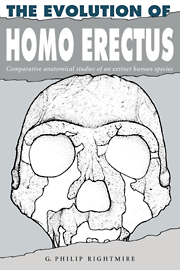Book contents
- Frontmatter
- Contents
- Preface
- 1 Introduction
- 2 Homo erectus in the Far East
- 3 Homo erectus at Olduvai Gorge
- 4 Discoveries from the Turkana basin and other localities in sub-Saharan Africa
- 5 Northwest Africa
- 6 Comparisons of African hominids with Asian Homo erectus
- 7 Homo erectus as a paleospecies
- 8 The transition to more modern forms
- 9 Summary and prospects for further research
- References
- Author index
- Subject index
5 - Northwest Africa
Published online by Cambridge University Press: 14 October 2009
- Frontmatter
- Contents
- Preface
- 1 Introduction
- 2 Homo erectus in the Far East
- 3 Homo erectus at Olduvai Gorge
- 4 Discoveries from the Turkana basin and other localities in sub-Saharan Africa
- 5 Northwest Africa
- 6 Comparisons of African hominids with Asian Homo erectus
- 7 Homo erectus as a paleospecies
- 8 The transition to more modern forms
- 9 Summary and prospects for further research
- References
- Author index
- Subject index
Summary
The first hominid from northwest Africa showing a resemblance to Homo erectus was discovered in 1933. The find was made by workmen quarrying in the consolidated dune of Kébibat, near Rabat on the Atlantic coast of Morocco (see Fig. 28). Only parts of a fragmented vault, the left maxilla, and the lower jaw of a subadult individual were recovered. Uncertainties concerning the dating of these fossils have still not been resolved, although it is agreed that they are of later Middle Pleistocene age. Controversy over the significance of the Rabat hominid has also persisted. The bones have been linked to Homo erectus by some workers, or viewed at least as intermediate in their morphology between archaic and more modern humans. Saban (1977) suggests that the occipital bone exhibits a pattern of endocranial vascular and cerebral markings which is primitive, while the external surface lacking a transverse torus is more advanced in form. The mandible also retains numerous archaic characters, although the symphysis ‘foreshadows’ the condition seen in Homo sapiens. Evidence of this sort is interpreted to show that a northwestern African Homo lineage became progressively more modern in the later Pleistocene. Other workers including Howell (1978) prefer simply to assign the fossils to Homo sapiens. The mandible does appear to be more lightly constructed than any of the jaws discovered 20 years later at Ternifine in Algeria. The corpus displays little lateral relief, and elements of a bony chin are clearly present.
- Type
- Chapter
- Information
- The Evolution of Homo ErectusComparative Anatomical Studies of an Extinct Human Species, pp. 119 - 137Publisher: Cambridge University PressPrint publication year: 1990



